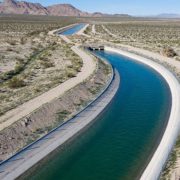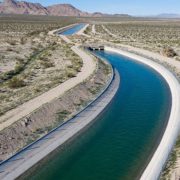Water Authority Supports Talks on Fed Draft Colorado River Proposal
The San Diego County Water Authority supports a consensus-based approach for long-term solutions to water supply issues in the Colorado River Basin. The U.S. Bureau of Reclamation on April 11 released a draft environmental document that considers changes to near-term operations on the Colorado River, including potential reductions in water supplies for California and across the Lower Colorado River Basin.
Colorado River Proposal
Reclamation’s draft Supplemental Environmental Impact Statement (SEIS) analyzes two alternatives, plus a no-action alternative, to protect critical elevations at Lakes Mead and Powell, the two reservoirs California depends on for its river supplies. Both reservoirs have declined due to unprecedented low levels from more than two decades of drought.
The release of the draft SEIS, which would modify the set of operating guidelines that manage river operations through 2026, comes even as heavy snows this winter signal some relief on the river.
Collaboration and consensus-based approach
“While this winter’s storms delivered an incredible snowpack, the release of the draft SEIS highlights that we need to continue to work with all Basin states, the tribes and Mexico toward a consensus-based approach that provides real and lasting solutions for all water users,” said Dan Denham, deputy general manager for the San Diego County Water Authority.
To address potential for low run-off/unprecedented water shortages in #CORiver Basin, @usbr today released a draft Supplemental Environmental Impact Statement to potentially revise current interim operating guidelines for near-term op.s of Glen Canyon & Hoover Dams. pic.twitter.com/XnjnjJe7BU
— Bureau of Reclamation (@usbr) April 11, 2023
The first of the two action alternatives in the draft SEIS acknowledges the priority system for water rights under existing agreements and laws. The San Diego region’s river supplies are largely protected from reductions because they are tied to California’s senior rights within the Lower Colorado River Basin as well as the Imperial Irrigation District’s (IID) high priority rights through the Water Authority’s conserved water transfer agreement with IID.
The second alternative calls for Reclamation to analyze the effects of reductions “distributed in the same percentage” for all water users in the Lower Basin states – California, Arizona and Nevada – despite there being no precedent or foundation for this approach under existing laws. It would mean across-the-board reductions for all water users in the region, including those with senior water rights.
Reclamation has stated it is expecting input from states, tribes and water agencies to fine-tune and adjust these alternatives. Discussions are ongoing between stakeholders.
NEWS RELEASE 4-11-2023: Imperial Irrigation District General Manager Henry Martinez issued a statement on the draft Supplemental Environmental Impact Statement (SEIS) released today by the U.S. Bureau of Reclamation. https://t.co/FO0bFx7Ubj pic.twitter.com/VLLzQnOHaS
— IID (@IIDatWork) April 11, 2023
Colorado River Board of California
“The Water Authority will continue to work in collaboration with our partners on the Colorado River Board of California to ensure California’s high priority water rights on the river are upheld through this SEIS process while we also work with all river stakeholders to develop long-term, durable solutions for the river,” Denham said.
The draft SEIS will be available for public comment for 45 calendar days and the final SEIS is anticipated to be available with a Record of Decision in Summer 2023, according to the Bureau of Reclamation. Comments on the draft SEIS are due May 30. This document will inform the August 2023 decisions that will affect 2024 operations for Glen Canyon and Hoover Dams.
The proposal to address immediate water supply challenges complements Reclamation’s ongoing process to develop new guidelines for Colorado River Operations when the current interim guidelines expire at the end of 2026.




